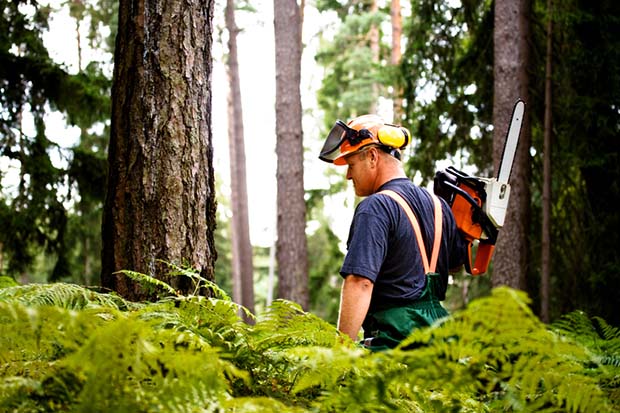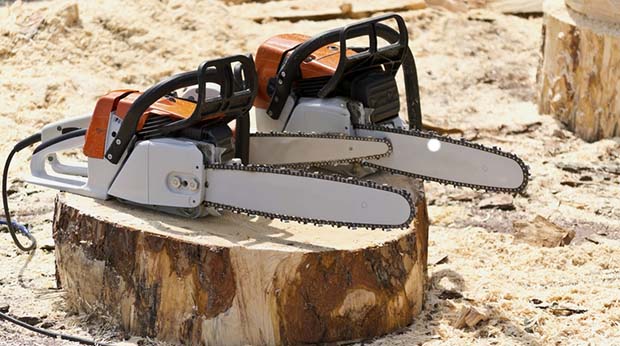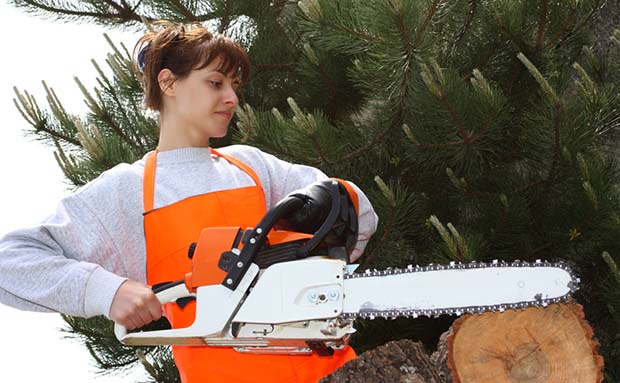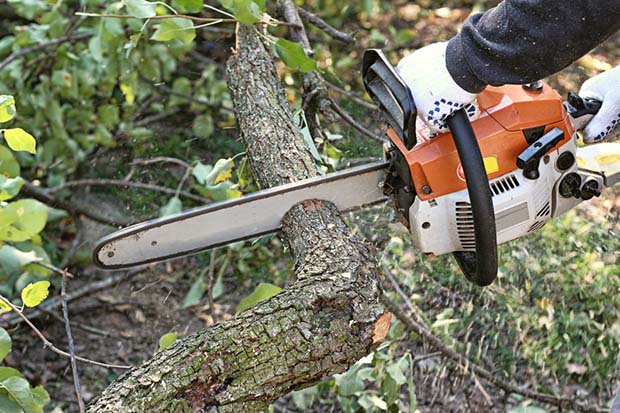A beginner’s guide to chainsaw safety

It’s important to wear the right safety gear when operating a chainsaw. Photo: Val_th | Dreamstime.com
As a nation of DIYers, many of us have a chainsaw lurking somewhere in a shed, but this is one tool that deserves your full respect, a good training regime and the correct safety equipment every time.
Words Nadene Hall:
Source: Chainsaw safety, www.acc.co.nz
The best tip for using a chainsaw is that if you aren’t confident, ask a professional for help or get them to do the job.
KNOW YOUR (AND YOUR MACHINE’S) CAPABILITIES
› If you don’t feel you have the skills for the job, there’s no shame in getting a professional to do it for you. Only a professional should attempt to cut down trees.
› Match the size and type of your chainsaw to the job at hand. Smaller chainsaws are less powerful and easier to use if you are new to using them, but limited in the size of tree they can cut. A larger, more powerful chainsaw is suited to felling larger trees. The guide bar length is also important – shorter ones are for using on branches, longer ones for felling.

Photo: Dreamstime.com
CHECK YOUR CHAINSAW
Before you start working with your chainsaw, check that:
› all parts are lubricated
› the chain is the right tension
› the teeth or cutting edges are sharp
› the depth gauge settings are correct
› all safety devices are in place and working
› there are no loose parts or bolts – if anything is missing or adjusted incorrectly, don’t use the chainsaw and take it to a qualified repair person
CHECK YOUR WORK AREA
Look for anything that could trip you up, such as electrical cables, or people (especially children, who should not be around in the first place) who might get in the way. Also check nothing is going to fall on you while you’re working, such as debris from higher up a tree.
NEVER DROP-START A SAW
Use cold start or warm start positions only. If you drop-start a saw it could swing in an arc and cause a serious injury. Learn more here.
WATCH FOR KICKBACK
Kickback (when the guide bar is thrown back towards you in an uncontrolled arc) can happen at any time. Usually the upper part of the bar nose hits a solid object or light material, or it’s pinched while cutting. It can also happen if your chain is loose or the depth gauge setting is too low. Most modern saws have a protective leather mitt attached to the front handle that can protect your hand and help prevent kickback. If your saw has one of these, make sure you use it correctly.
To reduce kickback:
› hold the chainsaw firmly with both hands
› always be aware of the location of the tip of the chainsaw – if possible, don’t let it touch anything
› take care when cutting light material (eg, twigs) that may catch in the chain
› use extreme caution re-entering a cut
› don’t over-file the depth gauges
› test the chain brake to make sure it works
NEVER CUT ABOVE SHOULDER HEIGHT
There is more chance of losing your balance, you can’t see what you’re cutting, and the chainsaw is more prone to kickback.

Photo: Sangot | Dreamstime.com
HOLD AND USE THE SAW CORRECTLY
Keep two hands on the saw and hold it close to your body, with the body of the saw close to what you’re cutting. Plant your feet firmly and slightly apart for balance. Never try to adjust it while the engine is running.
CUT ONLY ONE LOG AT A TIME
Remember that chainsaws are designed to cut wood – nothing else.
MAINTAIN YOUR SAW
Good maintenance will extend the chainsaw’s life and make it safer to use. When you finish chainsawing:
› make sure the air filters, sprocket cover and chain brake mechanism are free from sawdust
› clean the guide bar groove
› oil the holes and check everything is in place (do this each time before you use a chainsaw as well)
To maintain the chain of your saw:
› keep the chain sharp, with the correct cutter angles
› keep the machine well-oiled and properly tensioned
› follow the manufacturer’s specifications for correct depth gauge settings.
GEAR UP
It’s no exaggeration to say that wearing the right safety gear could save your life, so spend the few dollars it takes to buy safety gear and the few minutes it takes to use it. Safety gear is widely available at power tool suppliers and hardware stores, so make a point of getting what you need. Chainsaw safety gear includes:
› protective gloves
› chaps
› helmet
› safety glasses
› grade 4 or class 5 hearing protection
› solid (preferably steel-capped) boots
WHY YOU SHOULD BE SAFE, EVEN ON A LITTLE JOB
Brian Grant was wearing a T-shirt, shorts and jandals when he fired up his chainsaw. It was his kids who pointed out he didn’t have any safety gear on. Not wanting to set a bad example, he went and got his helmet, chaps and boots. It was a decision that would end up saving his life.
“I wasn’t going to bother with the safety gear because it was a nice hot day,” he says. “And I was only planning on doing a five minute job, trimming some branches off a tree.”
Luckily for him, his two children had recently been to a farm safety day where they had learned about chainsaw safety so Brian was wearing the correct protection when the chainsaw kicked back towards his head.
In a split second, he had fallen from his ladder and was on the ground. His helmet was ruined – when the chainsaw struck, it glanced off the visor and sliced through an earmuff.
The branch Mr Grant was cutting also came down with him, shredding his chaps in the process.
It was a very lucky escape.
“Without my helmet, the chainsaw would have ended up in my head. And without the chaps, my legs would have been ground to the bone.”
He acknowledges he took some other risks that day. For instance, he was using the chainsaw up a ladder. Another rule he broke was to hold the chainsaw above his head, as he stretched to reach some high branches.
“I’m a bit embarrassed because I was doing all the wrong things, and I knew that,” says Brian. “I won’t pick up the saw without proper gear now. Even for a five minute job.”
SAFE CHAINSAW USE REQUIRES KEY DAILY SAW CHECKS
Throttle lock-out – ensures the throttle only functions when the rear handle is held securely, check that the trigger cannot be operated until the lockout is depressed.
Mitt – attaches to this bar to prevent your left hand coming off the front handle so long as your left thumb is held correctly under the handle.
Muffler – reduces noise and directs exhaust gases away from the operator
Spark arrester – catches sparks in the exhaust gases. Set carburettor so chain is stationary when saw is idling.
Rear hand guard – protects the right hand from debris and broken chains. Check the chain for cracked rivets or links.
Anti-vibration mounts – reduces the amount of vibration felt by the operator’s hands. Should be checked every time you use it for wear.
On-off switch – can quickly turn saw off with thumb when holding rear handle with right hand. Test every time you use chainsaw to make sure the engine stops immediately.
Chain catcher – catches the chain if it breaks and prevents it from hitting the operator. Check every time you use chainsaw to make sure it is undamaged.

STOP AND THINK ABOUT EVERY CUT
Thinking about the task before you attempt it can help reduce injuries. Before you start, make sure you have the right equipment and a safe environment to do the job. Here are some key things you need to remember:
› One chainsaw does not fit all jobs – what’s good for cutting firewood may not be suitable for cutting smaller pieces of timber.
› Only use a chainsaw while you are on the ground, and never lift it to use above shoulder height.
› Chainsaws are designed to cut wood – never use one to cut other materials.
› Know your skill level – for example, never try to cut down trees, unless you’re a professional.
› Stay alert – if you’re tired, stop and rest.
› Get to know the manufacturer’s safety features.
WHY ARE CHAINSAWS PARTICULARLY DANGEROUS?
It’s easy to see why a chainsaw is a tool you need to work carefully with: powerful, sharp teeth, spinning at high revolutions.
But it’s the unforgiving nature of chainsaws that makes them so dangerous if it’s used incorrectly. By design, they don’t cut cleanly, so when they inflict injuries they are usually always serious.
IN THE KICKBACK ZONE
Never use this part of the bar – it is the most likely part of the bar to cause kickback, gripping the timber and then throwing the saw and blade backwards with force. The first part of you it will hit is your face and then the top of your head
USING A CHAINSAW SAFELY
› Always start a chainsaw with it sitting on the ground.
› When using a chainsaw, do not over-reach – always move your feet to get close to the cutting position.
› Use correct techniques to avoid cutting your left foot or leg – the left hand side is more at risk of injury because chainsaws tend to be operated by the right hand.
› Use the lightest saw and shortest bar for the job, keeping the motor size and bar length balanced.
› Avoid cutting with the tip of the saw – this increase the chance of kickback.
› Do not make cuts that will result in a log rolling dangerously.
› When moving around, switch off the saw or engage the chainbrake and carry the saw in both hands.
› Refuel with the motor off, away from sources of ignition – no smoking.
› Use the decompression button when cold starting.
EXTRA READING
Note: these are guides – they do not replace tutoring from an expert, which we highly recommend anyone who owns a chainsaw to complete. Watch Husqvarna’s experts show you the basics of using a chainsaw in their online video series.
 This article first appeared in NZ Lifestyle Block Magazine.
This article first appeared in NZ Lifestyle Block Magazine.
